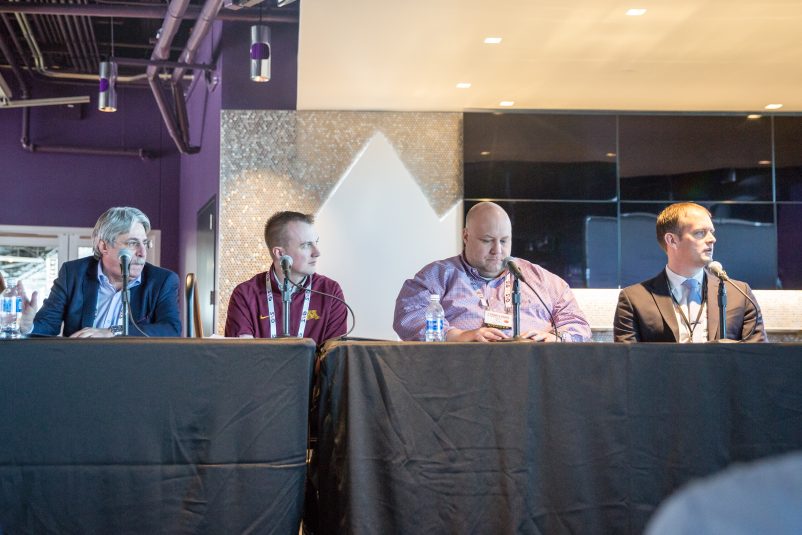Sports Venue Production Summit: With Control Rooms Handling More Content Than Ever, Flexibility Is Critical
Infrastructure technologies are being leveraged on more than just game days
Story Highlights
For the video side of a professional sports franchise or collegiate athletic department, the mothership of any venue is the control room. These days, with the demand for greater ROI from those facilities and, thus, an increase in events outside of game days, those control rooms — and their crews — are being asked to do more and more.
For that simple reason, control rooms these days require one thing over all else: flexibility.

From left: Evertz’s Joe Cirincione, University of Minnesota’s Joel Larsen, Alpha Video’s Jeff Volk, and U.S. Bank Stadium’s Tadd Wilson spoke on control-room strategies during the SVG Sports Venue Production Summit.
That was the main topic in a discussion of control-room technologies and infrastructure at SVG’s Sports Venue Production Summit at U.S. Bank Stadium in Minneapolis last week. The event’s host is a perfect example of this commitment to construction with an eye to the future. U.S. Bank Stadium is built around a hybrid system with a baseband and IP core but with the overhead for growth built largely on the IP end.
U.S. Bank Stadium hosts more than just Vikings games. It has quickly become a major venue for the Twin Cities events ranging from a handful of clients being entertained in a club space to the X Games coming to town this summer. Across town, the University of Minnesota’s TCF Bank Stadium, which opened in 2009, received similar treatment, anticipating and planning for more than the facility needed the stadium’s opening.
“Most of it has to do with infrastructure,” explained Jeff Volk, VP at Alpha Video, which built the control rooms in both venues and in more than 60 others across the country. “When we built the systems at the University of Minnesota, we made a request to pull 128 strands of fiber between those venues. There were people on campus who thought we were crazy. All of those fibers today are being used. Back five years ago, when we had a demand for 32 strands, we pulled 128 because it’s what made sense so we had some overhead for the future.”
Added Joel Larsen, live production operations manager, University of Minnesota Athletic Department, “All of our resources are being utilized more and more. We’re never going to be doing less than we’re currently doing. We’re going to be doing things at varying levels, but our resources are being used not just on seven football-game days anymore. They are being used 200 days a year for different club spaces, premium rentals, smaller spaces. [It’s important that you are] building and planning your resources for the future.”
In developing a new control room from scratch, the biggest challenge for clients, integrators, and technology partners is simply making the numbers line up.
“Unfortunately, in the past, clients would make a list that’s [very] big but [would say] we only have so much money and we have to fit it into a shoe box, basically,” said Joe Cirincione, VP, sales, sports and entertainment, Evertz. “With the way today’s technology is looking towards the future — which I firmly believe will be IP — instead of buying a router, which is 128×128 and you run out of room in a year, we’re putting IP infrastructures in, and it allows us to build more and more of these control rooms as needed. The neat thing about that is, the control room doesn’t have to be [at the venue]; it can be someplace else now.”
